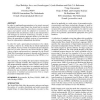Free Online Productivity Tools
i2Speak
i2Symbol
i2OCR
iTex2Img
iWeb2Print
iWeb2Shot
i2Type
iPdf2Split
iPdf2Merge
i2Bopomofo
i2Arabic
i2Style
i2Image
i2PDF
iLatex2Rtf
Sci2ools
100
click to vote
DL
1998
Springer
1998
Springer
Practical Application of Existing Hypermedia Standards and Tools
In order for multimedia presentations to be stored, accessed and played from a large library they should not be encoded as final form presentations, since these consume storage space and cannot easily be adapted to variations in presentation-time circumstances such as user characteristics and changes in end-user technology. Instead, a more presentation independent approach needs to be taken that allows the generation of multiple versions of a presentation based on a presentation-independent description. In order for such a generated presentation to be widely viewable, it must be in a format that is widely implemented and adopted. Such a format for hypermedia presentations does not yet exist. However, the recent release of SMIL, whose creation and promotion is managed by the World Wide Web Consortium, promises to become such a format in the short term and be for hypermedia what HTML is for hypertext. The technology for enabling this presentation-independent approach is already availabl...
Digital Library | DL 1998 | Final Form Presentations | Presentation Independent Approach | Presentations |
Related Content
| Added | 05 Aug 2010 |
| Updated | 05 Aug 2010 |
| Type | Conference |
| Year | 1998 |
| Where | DL |
| Authors | Lloyd Rutledge, Jacco van Ossenbruggen, Lynda Hardman, Dick C. A. Bulterman |
Comments (0)

